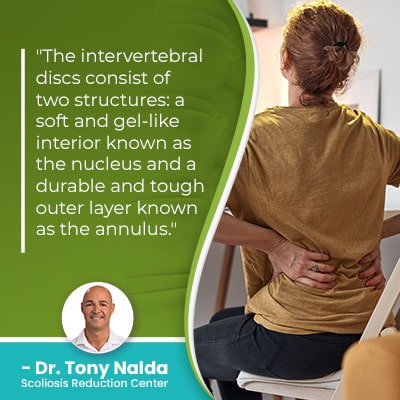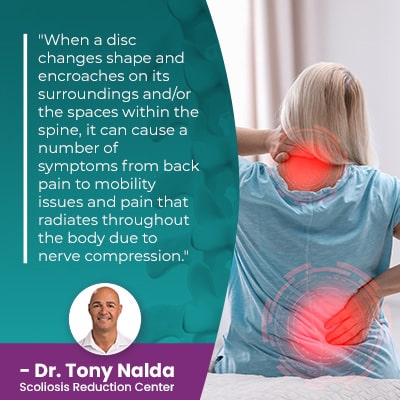Herniated Disc & Bulging Disc Treatment Options

There is a certain amount of spinal degeneration that's expected with age, and generally, it's the intervertebral discs that are the first structures of the spine to deteriorate. The spinal discs are fairly simple in design, but play many complex roles; continue reading to understand the connection between disc health and overall spinal health.
The spine is only as healthy as its individual parts, which all work together to preserve spinal health and function. When it comes to bulging disc treatment, its underlying cause and severity will shape the design of effective treatment plans.
Understanding basic spinal anatomy is key when it comes to understanding disc conditions such as bulging and/or herniated discs.
Table of Contents
Anatomy of the Spine
The spine is a complex structure that allows us to stand upright, practice good posture, engage in a wide range of flexible movement, protects vital organs, and works with the brain to form the body's central nervous system (CNS).
In order for the spine to function optimally as it was designed, it needs to maintain its natural curves and alignment.
The spine consists of three main sections: cervical spine (neck), thoracic spine (middle/upper back), and the lumbar spine (lower back).
Each section has a characteristic curvature type that either bends inwards, towards the body's center, or outwards, away from the body's center, and it's these curves that give a healthy spine its soft 'S' shape when viewed from the sides, while appearing straight when viewed from the front and/or back.
The spine consists of bones, called vertebrae, that are stacked on top of one another in a straight and neutral alignment, and adjacent vertebrae are separated by an intervertebral disc.
Intervertebral Disc Anatomy
 The intervertebral discs consist of two structures: a soft and gel-like interior known as the nucleus and a durable and tough outer layer known as the annulus.
The intervertebral discs consist of two structures: a soft and gel-like interior known as the nucleus and a durable and tough outer layer known as the annulus.
The discs are made of water, collagen, and proteoglycans, and they are the largest structures inside the body without their own vascular supply, meaning no direct path into and out of the discs through which blood and nutrients can pass and waste can be removed.
The discs absorb nutrients and oxygen needed from its surroundings through a process akin to osmosis.
Role of the Intervertebral Discs
As mentioned, the discs play many important roles necessary for optimal spinal health and function.
The discs provide the spine with structure as adjacent vertebrae attach to the disc in between, and this is why when a disc changes shape, it can affect the integrity of the spine's healthy curves and alignment by altering the position of adjacent vertebrae.
The discs also combine forces to facilitate a range of flexible movements like bending, twisting, and turning.
When it comes to friction and deterioration from the vertebrae rubbing against one another, the disc in between prevents this, and in addition, will act as shock absorbers so stress is evenly absorbed/distributed along the spine.
As a spinal structure, disc issues can affect the spinal nerves that run through the spinal cord and spinal canal, and spinal nerve inflammation can cause a number of symptoms.
In light of the key roles of the intervertebral discs, it's understandable that the discs are the spinal structures most vulnerable to deterioration.
What's a Bulging Disc?
A bulging disc occurs when its inner nucleus is pushing outwards against its outer annulus, causing it to bulge excessively; think of a marshmallow squeezed between two crackers.
When the nucleus is bulging outwards, this is changing the disc's shape, making it lose height, becoming flatter, and encroach on the space used by spinal nerves in the area.
If left untreated, a bulging disc can become a herniated disc.
What's a Herniated Disc?
When a bulging disc becomes a herniated disc, this means its inner nucleus has poked through a tear in its outer annulus layer, and this also means the disc is changing shape and taking up space needed for the spinal nerves to function optimally within.
 When a disc changes shape and encroaches on its surroundings and/or the spaces within the spine, it can cause a number of symptoms from back pain to mobility issues and pain that radiates throughout the body due to nerve compression.
When a disc changes shape and encroaches on its surroundings and/or the spaces within the spine, it can cause a number of symptoms from back pain to mobility issues and pain that radiates throughout the body due to nerve compression.
Disc issues are the cause of a number of spinal conditions, particularly those related to spinal degeneration and/or nerve compression.
If a disc deteriorates to the point of changing shape, in light of its many functions, particularly on the structural side, it will affect the disc's surroundings, which includes the spine and its nerves.
For example, a herniated lumbar disk can compress the sciatic nerve that starts in the lower back, and cause sciatic nerve pain felt anywhere along its extensive pathway down the back of the lower body.
Bulging Disc Symptoms & Treatment Options
When it comes to bulging disc and/or herniated disc treatment options, the approach will depend on condition cause, severity, and experienced symptoms.
Sometimes, a bulging disc doesn't cause noticeable symptoms, but if left untreated, it can easily become a herniated disc, which can produce overt symptoms.
Symptoms of a bulging and/or herniated disc can include:
- Back pain
- Nerve pain
- Leg pain
- Tingling/numbness felt in the area of the body located closest to the affected spinal disc
- Electric shock-like sensations
- Mobility issues
- Muscle spasms
- Muscle weakness
- Issues with bowel or bladder control (common with cauda equina syndrome)
- Reduced range of motion and spinal flexibility
When it comes to a proactive conservative treatment approach, we're talking about counteracting the effects of natural age-related spinal degeneration, preserving disc function, and improving disc health.
Bulging Disc Treatment Options
Here at the Scoliosis Reduction Center, through an integrative approach, I combine different forms of treatment for the best potential results and so that treatment plans can be fully customized.
Through condition-specific chiropractic care, I can address areas of vertebral subluxation because when a vertebral body is aligned with the rest of the spine, its natural curves are in place, relieving pressure on the spinal discs and nerve roots.
In addition, chiropractic adjustments can help facilitate the ability of the nucleus to reclaim its central position inside the annulus.
Through physical therapy, I can work towards strengthening the core muscles so the spine is optimally supported, taking pressure off the spine and its parts.
In addition, physical therapy and exercise can help increase circulation in an affected area, which is the only way to make nutrients and oxygen more available to the discs as they absorb these things from their surroundings.
When it comes to pain relief, the most effective long-term results can only be achieved through proactive treatment; only a small percentage of disc issues will resolve on their own.
The reality is that when it comes to degenerative disc disease and spinal degeneration, deterioration that's already occurred slowly over time is difficult, if not impossible, to fully reverse, which is why the treatment focus is on preserving current function and preventing further degeneration.
Conclusion
Bulging discs and herniated discs can sometimes be prevented through positive lifestyle choices such as maintaining a healthy weight, activity level, practicing good posture, and using proper lifting techniques.
While there is a natural degree of spinal degeneration to be expected with age, the aforementioned lifestyle factors play a role in determining whether that natural level/rate of deterioration is minimized or maximized.
The main underlying cause of bulging discs and herniated disks is spinal degeneration.
As the discs are generally the first spinal structures to feel the effects of deterioration, and in light of their many important roles, that degeneration can have a big impact on the spine's overall health and function.
Once a disc changes shape, it affects the position of adjacent vertebrae, which can lead to the development of an unnatural spinal curve and/or a misaligned spine.
When the spine is misaligned, a lot of uneven forces are introduced to the spine, its surroundings, and the body in general.
A bulging disc occurs when the inner nucleus is pushing outwards against its outer layer (annulus), causing it to bulge around its perimeter, and if the bulging disc's inner nucleus actually pushes through a tear/rupture in disc's tough outer wall, it becomes a herniated disc.
While prescription pain medication, epidural steroid injections, and nonsteroidal anti inflammatory drugs is a medicinal treatment option, this is only addressing the related symptom of pain, but isn't treating the condition itself by addressing its underlying cause.
While some disc issues can resolve on their own with a few weeks of bed rest, those that are more severe will require treatment so complications requiring spinal surgery don't develop in the future.
Here at the Center, I specialize in nonsurgical treatment for a variety of spinal conditions/issues, including bulging and/or herniated discs, and design treatment plans around condition causation, severity, and experienced symptoms.
Dr. Tony Nalda
DOCTOR OF CHIROPRACTIC
After receiving an undergraduate degree in psychology and his Doctorate of Chiropractic from Life University, Dr. Nalda settled in Celebration, Florida and proceeded to build one of Central Florida’s most successful chiropractic clinics.
His experience with patients suffering from scoliosis, and the confusion and frustration they faced, led him to seek a specialty in scoliosis care. In 2006 he completed his Intensive Care Certification from CLEAR Institute, a leading scoliosis educational and certification center.
About Dr. Tony Nalda
 Ready to explore scoliosis treatment? Contact Us Now
Ready to explore scoliosis treatment? Contact Us Now





